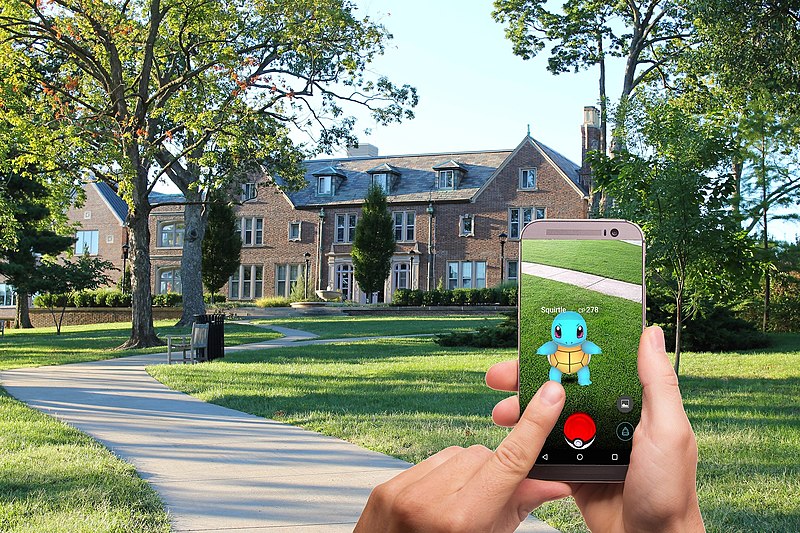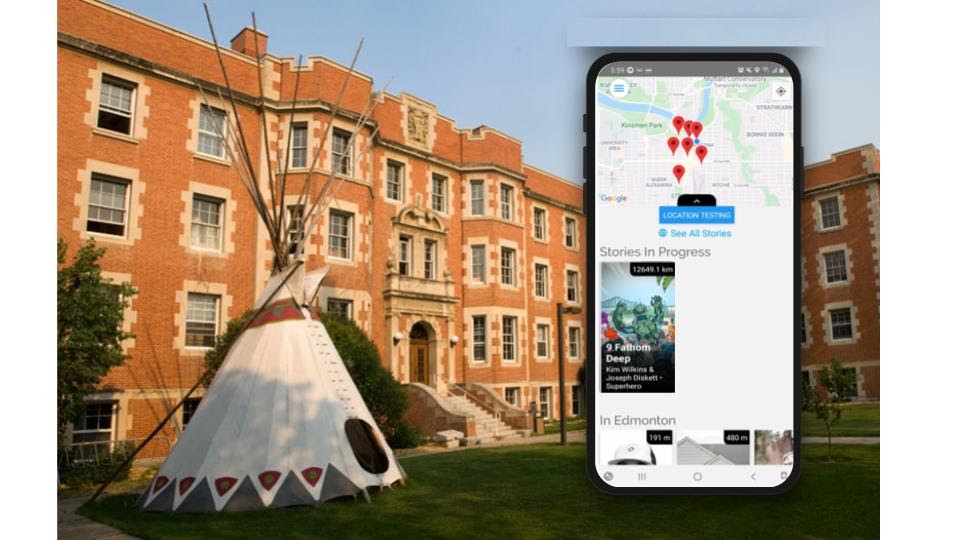It’s true that the pandemic has drastically accelerated the trends of dozens of different verticals, from the future of work, to education, to mobile entertainment, and interactive content is no exception. Gaming exploded across the pandemic, particularly in the mobile gaming and metaverse spaces, as people searched for ways to be interactive, connect, and build community that were COVID safe and entertaining.
And what was one of the most high growth trends in mobile gaming? Locative gaming and interactive storytelling.
It’s no surprise really, given the ‘history’ of this new medium pre-pandemic, the growing enthusiasm around audio in physical space, and the no code platforms that have activated a whole new generation of the creative economy building viable careers for a host of creative industries which were previously heavily gatekeepered (Publishing, broadcasting, gaming etc) because of high production costs and specialised skill-sets.
In this piece we’re going to dive into the trends that are quickly driving locative, interactive content (audio, video or otherwise) into being a strong contender as the next hit media format in the gaming, AR/VR space, and the next big frontier for creators across the globe.
LOCATIVE STORYTELLING & GAMING

Locative storytelling has been a medium for a little over a decade, and originally started with physical installations of stories and poetry in locations in various towns. Stories were told via scrabble tiles, QR codes, concrete acid washing, paint, and a myriad of other visual art mediums and were normally associated with arts or literary festivals. The niche of LARPing (Live Action Role Play) also falls into the locative storytelling category, and involves groups of enactors responding to a story scenario across a weekend event as though it were real life, with pre-created roles and responses for their assigned character. Geocaching, which started in 2000, also makes a game of hiding caches at GPS co-ordinates for ‘treasure hunters’ to find.
However, Locative storytelling and gaming with apps has only hit its stride in the past 5-7 years. Locative storytelling is experiences/stories that are designed to be completed in the real world using a digital overlay component such as an app for your mobile device.
Scavenger hunt company, ‘Stray Boots’, lead the way in 2009 creating systemised digital scavenger hunts for corporate team building functions using QR codes and early smartphones. But it wasn’t until independent app developing for iOS and Android really took off in 2012 that Stray Boots moved to a publicly accessible app that allowed users to complete scavenger hunts across several cities in the US.
In that same year Niantic (a Google spin off company) released two locative apps, ‘Field Trip’ which provided a digital tour guide experience, and ‘Ingress’ an interactive game that saw users split into two teams to create and battle over ‘portals’ which tagged specific real world locations. Ingress is still used by a cult following today with over 7 million regular users a month and 300,000 people worldwide turning up to developer organised events. The ‘Ingress’ database then became the base for Niantic’s most well know locative gaming app, ‘Pokemon Go’.
‘Pokemon Go’ has normalised the experience of walking the streets while taking part in a game/locative experience on your mobile device, training up an audience of over 1B+ people worldwide who are eager to engage in these types of experiences. ‘Pokemon Go’ is more gaming based than storytelling based, but still sees an average of 147 million monthly active users since the initial hype ‘died down’, netting an amazing $900M in 2019 four years after its initial release and pre-pandemic. What were the post-pandemic numbers you ask? An estimated $1.92B in 2020 from this one game.

The whole locative gaming market in general is estimated to have a CARG of 16% across the next 5 years.
The gaming/locative nature of these experiences has seen a large uptake/user base in domestic markets. And while it’s clear a lot of Pokemon Go’s success is because of the nostalgic IP (Niantic’s Harry Potter Wizard’s Unite didn’t do nearly as well when the game mechanics did not properly adapt to an audience base that while nostalgic, is also heavily narrative and characterization rather than collectible focused and needed vastly different types of game play), what’s also clear is that the bottle neck on proliferation of AR as a medium is a content one.
The high costs of development for Niantic and other studio locative games, result in long lead times for updates and new content/games, and restrict content creation and experimentation to game developers who understand the code needed to create. To see long term success in an expanded user base beyond nostalgic IP and techies, you need to allow for a rapid iteration process not only in the technology, but in the content – and that is the most likely in a no-code space.
None of the current locative storytelling/gaming platforms allow for the presentation and sale of content produced by outside content creators, nor do they focus on creating immersive stories over the top of their game states, merging local knowledge and culture with their experience to make it truly unique, or appealing to audiences that exist beyond gaming.
You now have a billion plus audience who understand how locative content works and the willingness to move through physical space to do it (particularly after the cabin fever of pandemic lockdowns, and the fear still surrounding interstate, let alone, international travel), yet your average creator doesn’t currently have the tools to tap into this market because of the strong technical learning curve and production costs.
So you have an eager audience, already trained in a new medium accelerated by a pandemic, and creators who are jumping on new creation avenues to rebuild careers heavily impacted by COVID. That a tipping point if I’ve ever seen one.
At Story City, we’re hyper focused in providing this creator toolkit and platform directly to non-technical creators, taking the market building of these predecessors, and unlocking the avenues for this untapped creator resource to overcome this content bottleneck.
WALKING TOURS & AUDIO GUIDES
Similar to the locative gaming space, walking tour apps have only started to gain traction in the past 5 years. While there are many local governments and institutions across the world that have touring apps for their city centres or premises, only a handful of ‘global’ companies are recommended across dozens of travel and tech websites as being top travel tour apps.
The first into the market of these was Cities Talking which launched its app in 2010 and has been slowly creating historical touring content for EU cities since then and is now called AnyTour. Niantic’s ‘Field Trip’ entered the market in 2012, then tour creation platform for museums ‘Stqry’ in 2012, followed by audio tour guide app ‘Detour’ in 2015 (which was then bought out by Bose to aid in their creation of their Bose AR audio platform).
All of these companies focused on US/EU cities, create their own curated first-party content (not open to creatives to create and sell), and only focus on non-fiction experiences using text and audio (no fiction, film, performing art, music). It appears to be the curated content model that is slowing the speed of their content creation/growth, for each of these companies have raised seed funding in excess of $1mill in the last 4 years. In recent years tour guide apps such as Vamonde and VoiceMap, have entered the market allowing individual creators to create their own walking tour/historical content for these apps, but have had such a narrow content focus that their products appeal mainly to a tourism market not a domestic/local market, stunting their growth and potential viral expansion to verticals outside the travel industry.
Why do we say that? When you compare the number of downloads on the iOS and Android app stores for locative gaming apps (Niantic, Zombies Run etc range between 250k-1B downloads) in comparison to travel tour guide apps (ranging between 50k-2M downloads), you see they have 100x more users than tour guide apps. It’s not a big surprise that domestic/local users gravitate to experiences that are entertaining, social, and playful rather than straight information dumps – hence the bumps in entertainment, streaming and gaming over ‘virtual’ armchair travel during the pandemic.
Despite that, the guide apps are a highly popular alternative to physical walking tours due to their convenience, and low cost. And even celebrity investors such as Kevin Costner, are jumping on the locative content train with a recent investment in new tour guide app, HearHere.
INDEPENDENT CONTENT PUBLISHING & COLLABORATION

The Creator Economy is estimated to be worth $200B by 2026. According to the most recent 2023 reports on the industry, 50M people consider themselves creators, and creators seek ownership of content and control of interactions with their audience, and a rise in demand for content during the pandemic culminating in the “Great Resignation” has seen an increased number of people entering the creator economy.
The idea of independent content creators being able to make a living apart from the large media, entertainment and publish corporations initially came into its own in the digital era with the proliferation of blogs. By mid-2004, blogs were starting to reach the mainstream with a study showing that over 32M American’s read blogs. At the time that was more than ten percent of the entire US population and it turned the newspaper industry upside down with its democratisation and easy dissemination of information.
Amazon, having become one of the world’s biggest online booksellers at the time saw the writing on the wall, and the problems present in being represented by the mainstream publishing industry, and launch Amazon Kindle and the publishing platform Kindle Direction Publishing (KDP) to the world in 2009. Like the invention of digital music sharing platforms before it, KDP completely disrupted the publishing industry opening a new market to writers, expanding across the planet by 2012.
As independent authors became more professional in their production thanks to the ecosystems that popped up around Amazon, Smashwords, Kobo and other ebook distributors, they started taking a much larger share of the publishing industry revenue and were responsible for $1.14B in ebook sales in 2018. In fact, mid-list authors – those who were popular enough to continue getting their books published by traditional publishers, but not popular enough to earn J.K. Rowling type money – jumped into the hybrid or independent author ship and were finally able to make the living off writing which they’d never been able to achieve with traditional models. In 2017, the top 3000 independent authors on Amazon earnt over $200M.
Amazon then released ACX in 2012 that allowed 100k+ independent producers, voiceover narrators, and writers to collaborate and sell audio book versions of their work. This disruption to the audio book industry helped contribute to the almost 30% increase in audio book sales in 2018 (which is a $2.8B industry).
PC game distribution platform Steam made a similar revolution in the games industry over a decade ago when it opened its online storefront to games from third-party publishers. Independent creators were able to break away from the major gaming studios and get traction for their games which experimented with the format in ways the market had never seen before. The company alone is estimated to make $4.3B yearly ($1B attributed to independent game makers), not including its standard 30% cut on purchases of in-game content and expansions.
But as has happened with Amazon Kindle, the market quickly saturated to the point that a rival gaming platform, Epic Games was able to launch a competitor platform in 2018 to provide competition for gamers and creatives. It’s interesting to note that even independent game creators require tech heavy methods and coding knowledge to create these PC games, essentially cutting other creative disciplines out of being able to enter this market as independent creators trying to forge a career.
Or take the podcasting industry, brought into being with the invention of the iPod, with podcasts being coined as a phrase and added as a section in iTunes in 2005. And while it gained popularity at a slower rate than other creator platforms, by the time Serial was released by This American Life in 2014, during which it was listened to over 68M times, podcasting had grown into a tsunami that couldn’t be stopped with the industry now estimated to be worth $1B, from the 115k+ podcasts available world wide. Some companies such as Spotify are so convinced that this trend of audio entertainment will continue that they’ve shelled out hundreds of millions in acquisitions for companies and creators.
All of these platforms, from Amazon Kindle, to Steam, to Podcasting (Apple/Stitcher/Spotify), to YouTube etc caused their industries to boom (publishing, gaming, broadcasting/audio, video) because of the no-code access to creation tools and distribution that it gave your regular, everyday creator, allowing iteration on content, format, and the development of entire niches which paved the way for platforms like Wattpad, Twitch, Patreon, or OnlyFans.
Each of these platforms are now at a mature part of their trend cycle where Negative Network Effects (As noted by Paraj from Panoramic Ventures) are starting to come into play, where many of these creator economy platforms that were supposed to be the ‘liberation’ of the middle-class creator are now so saturated with content it’s almost impossible to build the same kind of career momentum with these days without pouring 20-30% of profits back into marketing.
As a result, those next big creator platforms will come from startups allowing no-code creations in media areas traditionally gatekeepered by studios and high technical learning curves. They will be disruptive companies that are entering at the bottom end of the market with offerings that are low tech enough to unlock large segments of workers who could not access or afford traditional offerings, as outlined by Li Jin’s (ex-a16z, now Atelier Ventures) in depth analysis of how the passion economy will disrupt media, education and countless other industries.
When we look at locative content and AR/VR this is what Story City sees as the massive bottle neck – there is so much focus on the fancy tech that it is prohibitively expensive and technical for creators to make the content needed for a market like locative, interactive content to take off – and without the content and experimentation in that format the potential economic value of this market will struggle to be realised. Which is bananas considering the large pool of under-served demand – a local audience of over 1B+ people hungering for new content in their cities. At the moment this is what we’re tackling as a company at Story City – building that low-end, no code entry point for passion economy workers and previous non-consumers in interactive content.
What is exciting about Story City’s market is it can tap into creators from several creative industry verticals, from gaming, to publishing, to film and TV, to live performers, to documentaries. We are using the traction of the independent creation movement, and audiences flocking to locative apps like Pokemon Go, to open the format up to multiple industries that contribute to that $200B 2026 number.
We’ve seen a lot of investors and technologists ask is location-based content something creators are dying to create for? And it’s really this creator no-code tool trend that really encompasses the answer to that, because the prior is not really the right question, the right question is what are the associated trends that make adoption of this highly likely? In this market creator tools for your average creator gig economy have never existed (but as tool such as Dorian come into being, creators are quickly taking notice). The above history of these platforms show that what creators are dying for are new platforms that make full-time creative careers a possibility, particularly as those once pioneer platforms continue to saturate and provide decreasing returns due to increasing competition. Creators will flock to a platform just for the pleasure of creating (see Li Jin’s creator hierarchy of needs) but even more so if they can make money from their creations and it acts as advertisement for their other work.
If you provide the bridge between these creators who were previously non-producing because of the techological barrier, access to a new pool of previously unreachable audience, then the creators will be dying to create for location-based storytelling. But first you must link the two groups together. That is what Story City does as a platform, and that’s what the up and coming disruptive media and creator platforms will do.
Combine the above trends with the surge of ‘Revenge Travel‘, the preference of Millenials and GenZers towards experiences rather than things, the pandemic push from the EdTech industry towards Invisible Learning, and travel spending trending more and more towards sights, activities, and ‘authentic’ experiences, and you have the perfect melting pot for interactive and locative content to be the next big media of the 2020’s.
About Story City
The Canva for interactive storytelling, we’re building the future of interactive entertainment for non-gamers. Story City is a no-code platform and app for location-based content & games. Currently content creators are locked out of this AR market lacking the tools to create for this new and large global market. Our platform makes creation possible for your average creator unlocking both gaming & non-gaming audiences with this larger pool of talent.





